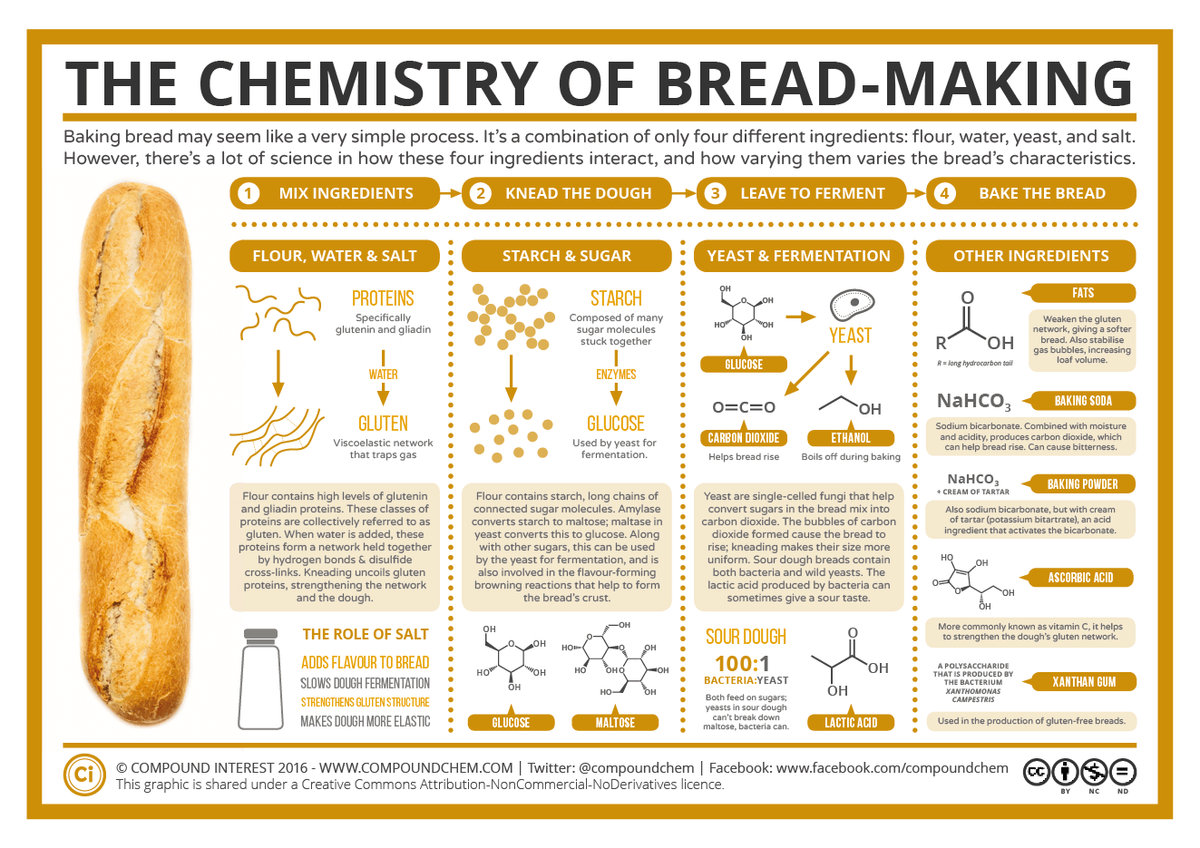As indicated in step 2 above, flour contans starch (complex sugar): 1) 1.00 cup of flour contains 68% starch. How many grams of starch is this? ( 1 cup = 120 g) 2) Recipe calls for 3.25 cups of flour. How many grams of starch are in the bread?
As indicated in step 2 above, flour contans starch (complex sugar): 1) 1.00 cup of flour contains 68% starch. How many grams of starch is this? ( 1 cup = 120 g) 2) Recipe calls for 3.25 cups of flour. How many grams of starch are in the bread?
Chemistry & Chemical Reactivity
10th Edition
ISBN:9781337399074
Author:John C. Kotz, Paul M. Treichel, John Townsend, David Treichel
Publisher:John C. Kotz, Paul M. Treichel, John Townsend, David Treichel
Chapter1: Basic Concepts Of Chemistry
Section: Chapter Questions
Problem 5PS
Related questions
Question
As indicated in step 2 above, flour contans starch (complex sugar):
1) 1.00 cup of flour contains 68% starch. How many grams of starch is this? ( 1 cup = 120 g)
2) Recipe calls for 3.25 cups of flour. How many grams of starch are in the bread?

Transcribed Image Text:THE CHEMISTRY OF BREAD-MAKING
Baking bread may seem like a very simple process. It's a combination of only four different ingredients: flour, water, yeast, and salt.
However, there's a lot of science in how these four ingredients interact, and how varying them varies the bread's characteristics.
MIX INGREDIENTS
2 KNEAD THE DOUGH
LEAVE TO FERMENT
BAKE THE BREAD
FLOUR, WATER & SALT
STARCH & SUGAR
YEAST & FERMENTATION
OTHER INGREDIENTS
FATS
PROTEINS
STARCH
Specifically
glutenin and gliadin
Composed of many
sugar molecules
stuck together
Weaken the gluten
network, giving a softer
bread. Also stabilise
HO
YEAST
OH
R
gas bubbles, increasing
loaf volume.
GLUCOSE
R= long hydrocarbon tail
WATER
ENZYMES
O=C=0
NaHCO,
BAKING SODA
HO.
GLUTEN
GLUCOSE
Sodium bicarbonate. Combined with moisture
Viscoelastic network
that traps gas
Used by yeast for
fermentation.
CARBON DIOXIDE
ETHANOL
and acidity, produces carbon dioxide, which
can help bread rise. Can cause bitterness.
Helps bread rise
Boils off during baking
NaHCO,
+ CREAM OF TARTAR
BAKING POWDER
Flour contains high levels of glutenin
and gliadin proteins. These classes of
proteins are collectively referred to as
gluten. When water is added, these
proteins form a network held together
by hydrogen bonds & disulfide
cross-links. Kneading uncoils gluten
proteins, strengthening the network
and the dough.
Flour contains starch, long chains of
connected sugar molecules. Amylase
converts starch to maltose; maltase in
yeast converts this to glucose. Along
with other sugars, this can be used
by the yeast for fermentation, and is
also involved in the flavour-forming
browning reactions that help to form
the bread's crust.
Yeast are single-celled fungi that help
convert sugars in the bread mix into
carbon dioxide. The bubbles of carbon
Also sodium bicarbonate, but with cream
of tartar (potassium bitartrate), an acid
ingredient that activates the bicarbonate.
dioxide formed cause the bread to
rise; kneading makes their size more
uniform. Sour dough breads contain
both bacteria and wild yeasts. The
lactic acid produced by bacteria can
sometimes give a sour taste.
HỌ
OH
ASCORBIC ACID
OH
он
OH
он
OOH
More commonly known as vitamin C, it helps
to strengthen the dough's gluten network.
THE ROLE OF SALT
SOUR DOUGH
OH
ADDS FLAVOUR TO BREAD
100:1
A POLYSACCHARIDE
THAT IS PRODUCED BY
THE BACTERIUM
HO
он
но
OHO
OH
SLOWS DOUGH FERMENTATION
ÕH
BACTERIA:YEAST
XANTHAN GUM
OH
ÓH
XANTHOMONAS
CAMPESTRIS
но-
Both feed on sugars;
yeasts in sour dough
can't break down
maltose, bacteria can.
STRENGTHENS GLUTEN STRUCTURE
MAKES DOUGH MORE ELASTIC
GLUCOSE
MALTOSE
LACTIC ACID
Used in the production of gluten-free breads
© COMPOUND INTEREST 2016 - Www.COMPOUNDCHEM.COM | Twitter: @compoundchem | Facebook: www.facebook.com/compoundchem c
This graphic is shared under a Creative Commons Attribution-NonCommercial-NoDerivatives licence.
BY
NC
ND
Expert Solution
This question has been solved!
Explore an expertly crafted, step-by-step solution for a thorough understanding of key concepts.
Step by step
Solved in 3 steps with 3 images

Knowledge Booster
Learn more about
Need a deep-dive on the concept behind this application? Look no further. Learn more about this topic, chemistry and related others by exploring similar questions and additional content below.Recommended textbooks for you

Chemistry & Chemical Reactivity
Chemistry
ISBN:
9781337399074
Author:
John C. Kotz, Paul M. Treichel, John Townsend, David Treichel
Publisher:
Cengage Learning

Chemistry: The Molecular Science
Chemistry
ISBN:
9781285199047
Author:
John W. Moore, Conrad L. Stanitski
Publisher:
Cengage Learning

Introductory Chemistry: A Foundation
Chemistry
ISBN:
9781337399425
Author:
Steven S. Zumdahl, Donald J. DeCoste
Publisher:
Cengage Learning

Chemistry & Chemical Reactivity
Chemistry
ISBN:
9781337399074
Author:
John C. Kotz, Paul M. Treichel, John Townsend, David Treichel
Publisher:
Cengage Learning

Chemistry: The Molecular Science
Chemistry
ISBN:
9781285199047
Author:
John W. Moore, Conrad L. Stanitski
Publisher:
Cengage Learning

Introductory Chemistry: A Foundation
Chemistry
ISBN:
9781337399425
Author:
Steven S. Zumdahl, Donald J. DeCoste
Publisher:
Cengage Learning

Chemistry & Chemical Reactivity
Chemistry
ISBN:
9781133949640
Author:
John C. Kotz, Paul M. Treichel, John Townsend, David Treichel
Publisher:
Cengage Learning

Chemistry
Chemistry
ISBN:
9781305957404
Author:
Steven S. Zumdahl, Susan A. Zumdahl, Donald J. DeCoste
Publisher:
Cengage Learning
